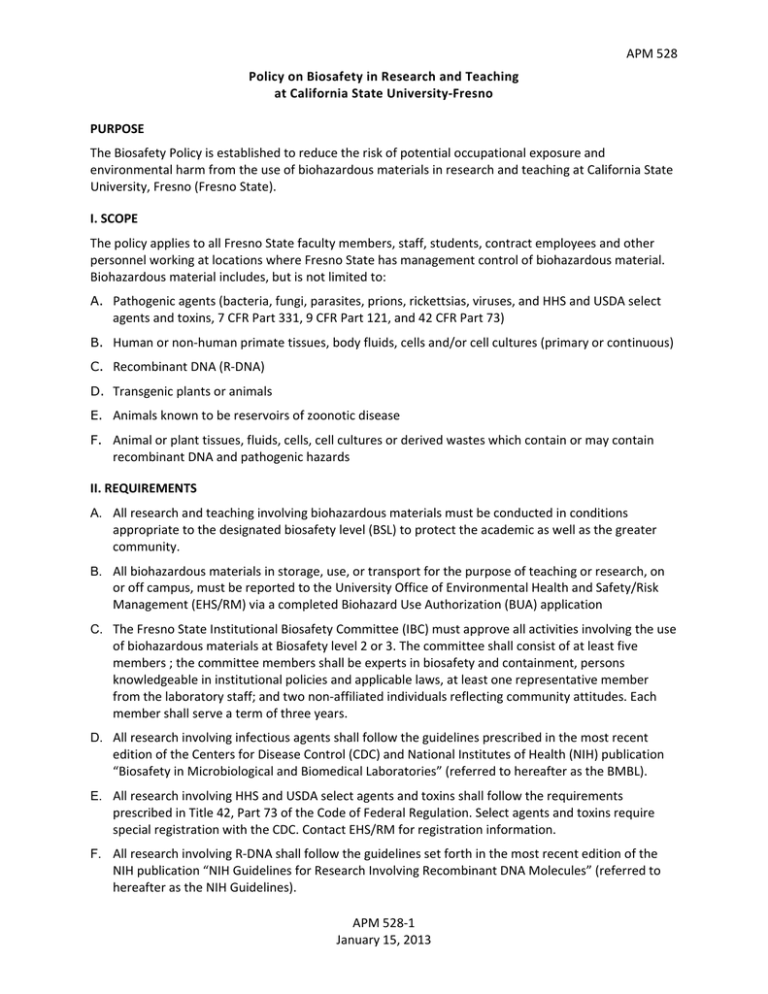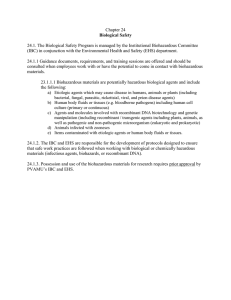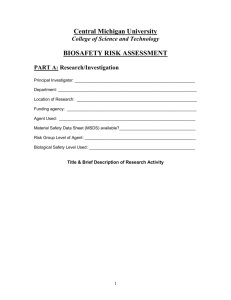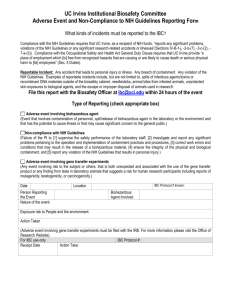APM 528 The Biosafety Policy is established to reduce the risk of potential occupational exposure and Policy on Biosafety in Research and Teaching
advertisement

APM 528 Policy on Biosafety in Research and Teaching at California State University‐Fresno PURPOSE The Biosafety Policy is established to reduce the risk of potential occupational exposure and environmental harm from the use of biohazardous materials in research and teaching at California State University, Fresno (Fresno State). I. SCOPE The policy applies to all Fresno State faculty members, staff, students, contract employees and other personnel working at locations where Fresno State has management control of biohazardous material. Biohazardous material includes, but is not limited to: A. Pathogenic agents (bacteria, fungi, parasites, prions, rickettsias, viruses, and HHS and USDA select agents and toxins, 7 CFR Part 331, 9 CFR Part 121, and 42 CFR Part 73) B. Human or non‐human primate tissues, body fluids, cells and/or cell cultures (primary or continuous) C. Recombinant DNA (R‐DNA) D. Transgenic plants or animals E. Animals known to be reservoirs of zoonotic disease F. Animal or plant tissues, fluids, cells, cell cultures or derived wastes which contain or may contain recombinant DNA and pathogenic hazards II. REQUIREMENTS A. All research and teaching involving biohazardous materials must be conducted in conditions appropriate to the designated biosafety level (BSL) to protect the academic as well as the greater community. B. All biohazardous materials in storage, use, or transport for the purpose of teaching or research, on or off campus, must be reported to the University Office of Environmental Health and Safety/Risk Management (EHS/RM) via a completed Biohazard Use Authorization (BUA) application C. The Fresno State Institutional Biosafety Committee (IBC) must approve all activities involving the use of biohazardous materials at Biosafety level 2 or 3. The committee shall consist of at least five members ; the committee members shall be experts in biosafety and containment, persons knowledgeable in institutional policies and applicable laws, at least one representative member from the laboratory staff; and two non‐affiliated individuals reflecting community attitudes. Each member shall serve a term of three years. D. All research involving infectious agents shall follow the guidelines prescribed in the most recent edition of the Centers for Disease Control (CDC) and National Institutes of Health (NIH) publication “Biosafety in Microbiological and Biomedical Laboratories” (referred to hereafter as the BMBL). E. All research involving HHS and USDA select agents and toxins shall follow the requirements prescribed in Title 42, Part 73 of the Code of Federal Regulation. Select agents and toxins require special registration with the CDC. Contact EHS/RM for registration information. F. All research involving R‐DNA shall follow the guidelines set forth in the most recent edition of the NIH publication “NIH Guidelines for Research Involving Recombinant DNA Molecules” (referred to hereafter as the NIH Guidelines). APM 528‐1 January 15, 2013 APM 528 1. Projects involving R‐DNA molecules that are listed as “EXEMPT” by the NIH Guidelines do not require NIH registration but must be approved by the IBC if the project involves BSL 2 or 3 agents. 2. Projects that are not exempt require NIH registration as well as IBC approval. III. RESPONSIBILITIES A. Institutional Biosafety Committee (IBC) is advisory to the University on all matters relating to the safe use of biohazardous materials. The IBC is responsible for: 1. Establishing and monitoring policies that meet or exceed applicable guidelines and regulations for use of biohazardous materials conducted at or sponsored by Fresno State. 2. Reviewing and approving proposed activities that use biohazardous materials designated as BSL 2 or above according to NIH Guidelines and/or BMBL. The review shall include an independent assessment of the containment required (practices, procedures, facilities and equipment used to safely manage biohazardous materials) and an assessment of the facilities, training and expertise of personnel involved in the research. The IBC shall ensure that the PI is provided with the results of the review and status of approval in a written letter and timely manner. The Chair of the IBC committee shall review and approve proposed activities that use biohazardous material designated as BSL 1 or are exempt status under NIH Guidelines and/or BMBL without further consultation with the IBC committee. 3. Setting required containment levels for research projects. The IBC will set the BSL based upon criteria recommended by the CDC and NIH as the standards of containment to be applied to the corresponding biohazardous materials. The IBC may, at its discretion, increase or reduce the BSL, depending on the circumstances presented by a specific project or biological criteria. 4. Investigating any research‐related accidents or illnesses or any significant violation of policies, practices and procedures. Reporting findings of its investigation and actions to the appropriate Fresno State officials and to the granting agencies. Recommending disciplinary measures in cases involving gross violation(s) of established biosafety practices and procedures. 5. Adopting emergency plans developed by EHS/RM and other Fresno State, local and state public health and safety departments governing accidental biohazardous materials spills and personnel contamination. 6. Determining when employees who work with biohazardous materials should be enrolled in medical surveillance. Determining which specific medical surveillance tests are appropriate for a given biohazardous materials risk. EHS/RM shall establish and maintain a medical surveillance program for at‐risk personnel. 7. Developing design specifications and criteria for containment. 8. Maintaining a diverse membership representing the community and a variety of university interests, consisting of two off‐campus community members and at least five members in total. 9. Convening once a semester or more often, as necessary, with at least one off‐campus community member present. B. EHS/RM is responsible for: APM 528‐2 January 15, 2013 APM 528 1. Being cognizant of all applicable laws, regulations, and guidelines and maintaining copies of all such documents as well as any amendments or modifications. 2. Developing requirements and guidelines for biohazard control, which are consistent with applicable federal, state and local laws and regulations. 3. Reviewing proposed research or instructional activities involving the use of biohazardous materials and preparing recommendations to the IBC. 4. Developing emergency plans for handling accidental spills and personnel contamination. 5. Investigating laboratory accidents involving biohazardous materials. 6. Developing and conducting training on biosafety issues, practices and procedures. 7. Reporting to the IBC any significant problems, violations of Fresno State biosafety policy, practices or procedures and any significant research‐related accidents or illnesses. 8. Implementing the recommendations of the IBC and assuring compliance by the PI. 9. Conducting periodic inspections to ensure that required laboratory practices and procedures are followed. 10. Reviewing biosafety facility construction/renovation plans and specifications. Inspecting construction/renovation and authorizing initiation of biohazardous materials work following construction/ renovation. Providing advice on biosafety facility design, ventilation needs and other support services. Advising on the selection, installation, maintenance and use of laboratory equipment that provides or aids in containment of biohazardous materials. 11. Coordinating the Fresno State Medical Waste Management Program. . 12. Ensuring the use of proper “Biohazard” signs and labels. 13. Establishing and maintaining a medical surveillance program for at‐risk personnel. C. Office of Research and Sponsored Programs (ORSP) is responsible for: 1. Ensuring that grant proposals utilizing biohazardous materials are referred to the IBC for review. 2. Notifying the IBC about funded grant proposals that utilize biohazardous material. D. Principal Investigator (PI) is the faculty member in whose assigned space a research activity is conducted. The PI performs and/or oversees activities that utilize or produce biohazardous materials. The PI is responsible for: 1. Developing specific protocols to ensure the safe use of biohazardous materials as set forth in the NIH guidelines and/or BMBL as well as applicable federal, state and local laws and regulations. Ensure that all laboratory personnel comply with the specific safety protocols. 2. Making initial determination of the required levels of physical and biological containment, as well as appropriate microbiological practices and laboratory techniques. 3. Ensuring that the containment equipment and facility requirements for activities performed under his/her direction meet the criteria for the appropriate BSL and certification standard. 4. Ensuring that all maintenance work in, on or around contaminated equipment is conducted only after that equipment is thoroughly decontaminated by the laboratory staff. APM 528‐3 January 15, 2013 APM 528 5. Developing specific protocols that outline proper emergency procedures for response to an accidental exposure of personnel or the environment to the biological agents and ensuring that all laboratory staff comply with the emergency procedures. 6. Submitting a BUA application and obtaining approval from the IBC prior to commencement of work. In addition, the PI is responsible for submitting any significant changes to the BUA application to the IBC for review and approval. 7. Submitting a new BUA application, revising an existing BUA if needed, or referencing an existing BUA when submitting a new grant proposal utilizing biohazardous material. 8. Obtaining approval from the different committees relevant to the project. For example, obtaining approval from the Institutional Animal Care and Use Committee (IACUC) if the project involves animals; the Institutional Review Board (e.g. Committee for the Protection of Human Subjects or CPHS) if the project involves human subjects; the Radiation Safety Officer (RSO) if the project involves radioisotopes. 9. Ensuring that all laboratory staff under his/her supervision are appropriately trained on the safe use of biohazardous materials and enrolled in medical surveillance, if appropriate. Training and medical surveillance include animal care personnel not directly supervised by the PI who provide husbandry and care for infected animals. 10. Complying with medical waste laws in handling medical waste in the laboratory and maintaining a designated medical waste autoclave or an approved medical waste accumulation area. 11. Ensuring that all laboratory staff, maintenance personnel and visitors who may be exposed to any biohazard are informed in advance of their potential risk and of the behavior required to minimize that risk. In addition, the PI is responsible for restricting access as required by the assigned biosafety containment level. 12. Reporting any significant problems, violations of the policies, practices and procedures set forth in BMBL, or any significant research‐related accidents and/or laboratory‐acquired infection to EHS/RM within 24 hours. 13. Complying with shipping requirements for biohazardous materials. These responsibilities extend to all aspects of biosafety including all individuals who enter or work in the PI’s laboratory or collaborate in carrying out the PIs research. Although the PI may choose to delegate aspects of the biosafety program in his or her laboratory to other laboratory staff, the PI is ultimately responsible for all activities occurring in his or her laboratory. E. Laboratory Staff is a laboratory worker who works in a technical capacity. The laboratory staff is responsible for: 1. Rigorously and conscientiously following laboratory‐specific biosafety practices and procedures. 2. Reporting to the PI or the laboratory manager all problems, spills or violations in procedure immediately, and reporting to EHS/RM any significant violations in biosafety policy, practices or procedures that are not resolved by the PI within a reasonable amount of time. Institutional Biosafety Committee Revised: January 15, 2013 APM 528‐4 January 15, 2013






